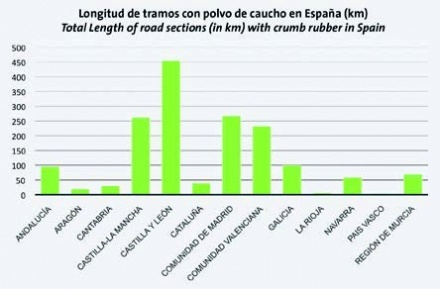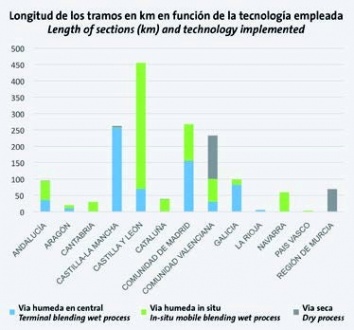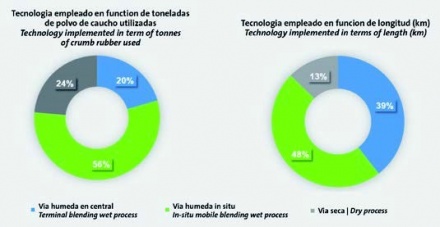Twenty years of modified asphalts in Spain
 SIGNUS is the non-profit company in charge of End-of-Life Tyres management in Spain
SIGNUS is the non-profit company in charge of End-of-Life Tyres management in Spain
Twenty years of modified asphalts in Spain
SIGNUS is the non-profit company in charge of End-of-Life Tyres management in Spain. Last May it published a book entitled: “Twenty years of modified asphalts on Spanish roads”. The article here following is a summary of the most important information contained in this book, which includes all road works that have implemented the use of this material in Spain during the last two decades.
Indeed, sensible political planning has allowed the promulgation of technical rules and regulations on the use of recycled rubber in modified asphalts in Spain almost 20 years ago. In particular, a specific regulation has acknowledged the benefits of this valid technology since then. For this reason, this regulation specifies how the Public Administrations have to prioritise the use of modified asphalts with recycled rubber. The result is that, as of today, over 1,600 km of roads have been created with modified asphalts in Spain. This technology allows asphalt to last up to 3 times longer than conventional ones. As a consequence, it needs less maintenance, thus drastically reducing costs. Moreover, it reduces the noise of passing vehicles and, thanks to the excellent grip on the surface, it improves adherence especially in case of rain, thus improving users’ safety.
The objective of the book is to promote the transformation of waste into a resource with high technological value. Moreover, it aims at highlighting the fact that the use of rubber powder recycled from End-of-Life Tyres in bituminous compounds is a consolidated technique of the sector, with over 1,600 km of roads made with this new generation of bituminous compounds in Spain. These roads have not deteriorated despite the passing of the years and the bad weather conditions they are exposed to. This is due to the fact that recycled rubber improves the properties of a road, making it more resistant and extending its duration. This has been demonstrated also by the photographic report present in the book, which shows the conditions of some stretches of road selected in different years.
Legislation of reference and types of modified binding agents
Important progress has been made in Spain for what concerns the promotion of the use of recycled rubber in bituminous compounds. The 2001-2006 national ELT (End-of-Life Tyres) plan specified that “in those public works where their use is technically and financially feasible, priority shall be given to materials deriving from ELT recycling processes”.
The General Management of roads for the Spanish Ministry of Public Works has ratified the circular order 5 bis /02 on the conditions for the use of recycled rubber in bituminous compounds. This order has modified articles 540, 542, and 543 of the general technical specifications for the building of roads and bridges (PG-3), in accordance with the ministerial order n. 891/2004. The latter has ratified the modification of the same PG-3 articles with the aim of establishing “the priority use of recycled rubber”, provided that such use was technically and financially feasible”.
Even if it is not a regulation, perhaps the most important part of the afore-mentioned legislative reform was the Guide to the use of recycled rubber from ELTs in bituminous compounds (2007). The Guide was written by CEDEX – the Spanish Centre for the Study and the Experimentation in Public Works – and commissioned by the Ministry of the Environment and the Ministry for Public Works. This document classified the three types of modified binding agents based on their maximum modification: rubber-improved binding agent, polymer-modified binding agent, and high-viscosity binding agent modified with rubber. They all use rubber recycled from ELTs.
A few months later, the Circular Order 21/2007 was published by the Ministry of Public works “on the use and the specifications that binding agents and bituminous compounds containing rubber have to comply with”. This has become the document that supervises the production and use of rubberised binding agents in Spain. As it will be shown further on in this article, this has been a key document and has coincided with a meaningful increase of the number of kilometres of roads built within the Spanish road network.
Techniques for the use of powders from recycled rubber in bituminous compounds.
The rubber powder can be incorporated into a bituminous compound by the means of one of these two following processes:
• “Wet” process: production of rubberised binding agents for the subsequent production of bituminous compounds. Two different production methods can be identified:
• Mixing of modified binding agents in the plant and subsequent transportation and storage of the rubberised binding agent in the bitumen mixing centre.
• Binding agents produced in situ at the mobile production unit of the modified binding agent located in the production plant of the bituminous compounds.
• “Dry” process: production of compounds adding rubber directly into the mixer together with the aggregates and the base binding agent at the production centre of the bituminous compound.
Works in progress with rubber recycled from ELTs
Almost 300 road maintenance interventions have been made with the use of rubber powder in Spain from 1996 to the first term of 2017. This is equivalent to about 1,600 km of roads and the consumption of almost 17,000 tonnes of recycled rubber. The information reported following each intervention made has been: year of execution, province, implemented technology (end mixing process, mobile process of in situ mixing, and “dry” process), length of the stretch of road, and estimate of the tonnes of rubber used. This simplifies the analysis of the implementation and consolidation of this technique in Spain for the past 20 years.

Picture 1 – Overall road length made with modified asphalts in the Autonomous Communities, in km Castilla y León is the Autonomous Community with the greatest experience in the use of powder from recycled rubber in bituminous compounds. Castilla-La Mancha, the Autonomous Community of Madrid and the one of Valencia follow (See picture 1).

Picture 2 – Length of stretches of road in km per Autonomous Community and used technology
As said before, it is estimated that almost 17,000 tonnes of recycled rubber have been used in these stretches of road. This is the equivalent of almost 4,000,000 automobile End-of-Life Tyres.
The analysis of the data based on the typology of implemented technology (see picture 2) shows that the “wet” mixing process is mainly used in Castilla-La Mancha, the autonomous community of Madrid, and Galicia. Instead, the mobile in situ combination with “wet” process is predominant in Castilla y Leon, Catalonia and Navarra. In the meantime, the “dry” process tends to be more used in the East of the country and, in particular, in the autonomous community of Valencia and in the Region of Murcia.
If the use of each technology is analysed at national level (Picture 3), 56% of the overall amount of recycled rubber has been added to the in-situ bituminous compound. This represents 48% of the length in kilometres of the surfaced stretches of road. On the other hand, if we observe the length of the stretches of road, the percentage of “wet” mixing process is three times higher than the “dry” one, despite the use of recycled rubber is similar for both processes.
Figure 4 shows the evolution of the stretches of road built using compounds of asphalt modified with recycled rubber in the course of the years. As it can be seen, the first stretches were built starting from 2002 and in 2004 - probably following the 2001-2006 ELT National Plan, and the Ministerial Order 891/2004.
However, a great increase in the use of this technology happened in 2007. Undoubtedly, this is due to the publication of the CEDEX Handbook, and, above all, as a consequence of the publication of the circular letter 21/2007. Moreover, it can be observed that there has been a sharp reduction since 2013. Among the various factors of this decrease, this can be due to the fact that these materials were still not widely known, despite the efforts of the General Management of Roads and of CEDEX with reference to the regulation related to these techniques. On top of this, the efforts of several research bodies and companies working in this sector are to be added. They have tried to make the rubber-modified binding agents, and, more in general, rubberised asphalt compounds technically feasible.

Fig 3 – Division by technology

Fig 4 – Length of stretches of road made every year until the first term of 2017
The publication of the book “Twenty years of modified asphalts on Spanish roads”, described in this article, together with the “Guide for the production of asphalts modified with recycled rubber” published in 2014 and the “Handbook of the production and the in-situ creation of modified asphalts” published in 2017 are part of an action plan designed by SIGNUS to promote the use of recycled rubber on roads and. Moreover, it aims at conforming with the additional requisites established within the frame of the 2016-2022 Waste Strategic Plan of the Ministry of the Environment. This plan was developed to give an answer to the politics of promotion of sustainability in the economic activities led by the package on the circular economy of the European Commission.
All these publications are freely downloadable at www.signus.es
SIGNUS Ecovalor is a non-profit organisation created as a collective management system at the disposal of all tyre producers and importers that have to comply with the legal obligations associated to End-of-Life tyres (ELTs). The mission of SIGNUS is to give an answer to the needs of society to live in a sustainable environment, guaranteeing that End-of-Life tyres receive an adequate treatment from the moment they are made to when they are transformed into precious raw materials. One of the most important ways for maximising this material is the use of rubber powders from End-of-Life tyres in bituminous compounds, because it gives them specific properties and it helps to close the cycle in compliance with the concept of circular economy.




